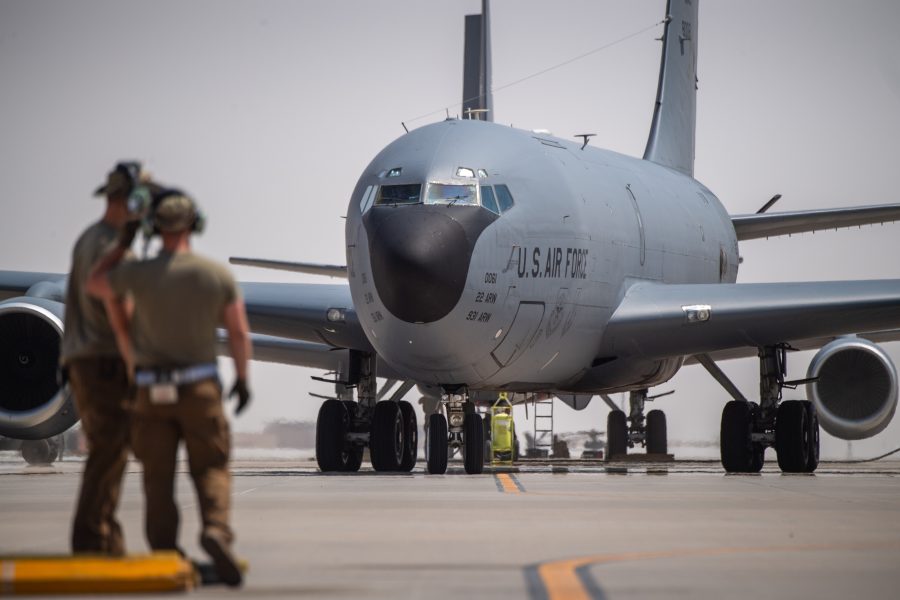NATIONAL HARBOR, Md.—The Air Force’s top acquisition official said Sept. 16 that longstanding plans to replace the KC-135 Stratotanker refueling jet with a similar airframe hinge on the progress of the service’s search for a more futuristic tanker.
That could leave the Air Force with a large swath of several-decade-old tankers as it waits for a next-generation model equipped to operate in a prospective war with other advanced militaries like Russia or China.
The service is slated to begin buying tankers under the Next-Generation Aerial Refueling System, or “NGAS,” program by the mid-2030s, leaving a decade to bridge the gap between the current KC-135 fleet—with airframes that average 60 years old—and a more advanced solution.
Air Force officials hope to launch NGAS sooner, which could eliminate the need for a one-for-one replacement of the KC-135, Assistant Secretary of the Air Force for Acquisition, Technology and Logistics Andrew P. Hunter told reporters at AFA’s 2024 Air, Space and Cyber Conference here. The KC-135 re-capitalization may supplant the stalwart Stratotanker’s less-advanced capabilities in the interim.
“We think there’s going to be some period, between when the current contract ends and when we’re truly into NGAS, where we’re going to need to buy something to cover down continued tanker production,” he said. “That construct is still the case, but it’s critically dependent on … how quickly we can get to NGAS.”
The NGAS program began almost two years ago as an assessment of the Air Force’s future options for refueling U.S. and foreign aircraft in midair. Service officials have argued those jets should be able to survive in areas where they may be targeted by anti-aircraft missiles, share data with other aircraft, and be more energy-efficient than previous fleets.
Lockheed Martin as well as a partnership between Northrop Grumman and startup JetZero have released design concepts for aircraft that could play in a next-generation tanker competition. Last week, the Air Force formally solicited industry’s input on potential mission systems for NGAS as a “first step in establishing competitive vendor pools,” Secretary Frank Kendall said in a morning keynote at the conference.
Another solicitation for airframes will come after the service’s review of what it might need in a modern tanker is done, Hunter added.
The Air Force had planned to gather industry’s proposals in fiscal 2025 for an airframe to replace the KC-135 ahead of NGAS’ arrival. A service spokesperson said last year the Air Force wanted to swap 15 KC-135s per year with that interim solution as they retire.
Now, how many aircraft the military might buy as part of a KC-135 recapitalization program is a “critical driver” of what the defense industry will offer, Hunter said—meaning companies may not see value in designing a new airframe from scratch for a smaller, lower-dollar acquisition.
“We need to understand the NGAS part of the story to truly make additional progress on tanker recap,” he said.
The NGAS design, in turn, also depends on what the Air Force wants in its Next-Generation Air Dominance initiative, which will center on a sixth-generation fighter that could pair with drone wingmen and control airspace in a war with other advanced militaries. The Air Force is now rethinking what capabilities an NGAD platform might need after several years of planning.
Abandoning a program comes with risks, too. In 2018, the Air Force scrapped an initiative to replace its E-8C Joint Surveillance Target Attack Radar jets with another airframe in favor of pursuing the Advanced Battle Management Network, a network of sensors and radars spread across other platforms. Critics accused the service of depriving service members of a critical airborne capability that had alerted ground troops to enemy forces that might be lurking nearby.
Discussion of future tankers comes as the Air Force continues downsizing two of its three aerial refueling fleets and bringing on the troubled KC-46 Pegasus, the U.S. military’s first 21st-century tanker program.
The Air Force expects to own about 350 KC-135s and nearly 120 KC-46s in fiscal 2025. Airmen will bid farewell to the final KC-10 Extender later this month as the fleet ends more than 40 years in service.
Congress has mandated that the Air Force own no fewer than 466 tanker aircraft, a number Hunter said the service believes is still feasible.
“Our current intention is not to propose an alteration in the statutory requirements for tanker aircraft,” he said. “That’s not to say that could never happen, but we don’t have anything to suggest to us that that current number is wrong.”
Airmen would continue to repair KC-135R jets until the service can replace them with something more capable, Hunter said.


